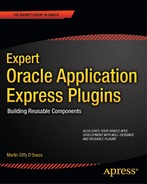Introduction
When APEX 4.0 was first released, I was very excited about all of the new features and fixes. The two new features that interested me the most were dynamic actions and plug-ins. I was fortunate to be able to write about dynamic actions in the Expert Oracle Application Express book earlier this year. When the opportunity presented itself to write a book entirely dedicated to plug-ins, I couldn't resist.
After writing countless examples on how to modify APEX on my blog, www.talkapex.com, I was ecstatic when plug-ins were introduced to APEX. They offer developers a standardized, declarative way to write customized objects in APEX and easily reuse them within an application. Of course, you can share plug-ins with your organization or even with the entire APEX community. I've written many free plug-ins, which can be found at plugins.clarifit.com and are available for download at www.apex-plugin.com.
Halfway through writing this book, APEX 4.1 was released. APEX 4.1 introduced some new features and enhancements to the plug-in framework, and I decided to go back and re-write several sections in this book to reflect the changes between versions. The only thing from the new plug-in features introduced in APEX 4.1 that is not covered in this book is the two new types of plug-ins: authorization and authentication. The four other types of plug-ins are covered in detail in this book, and you should be able to leverage the knowledge obtained from them to help yourself write authorization and authentication plug-ins.
This book provides you with all the necessary information to get a solid foundation of how to build an APEX plug-in. It also includes information on some tools that will be helpful to you when developing plug-ins. You may find it helpful to flip back and forth between your current page and Chapters 7 and 8, which focus on best practices, debugging, and tools.
Once you finish this book, or even get through the first example plug-in, I encourage you to try to create your own plug-in. It will feel awkward at first, and you will inevitably run into some issues on your first try. Don't get discouraged and stop. With some extra work, you will get the knack of how plug-ins work and will learn to love writing them soon enough. Once you get the hang of them, you will never go back.
My best advice for writing your first plug-in is to choose a really simple problem and go from there. The first time I took a stab at writing a plug-in, I had a complex issue I was trying to solve. After many hours, I had to scrap all my work and start over with the goal of solving a simple problem first. Throughout the book, I emphasize always listing out your requirements before writing a single line of code. I hope you follow this advice, which will inevitably save you time.
Good luck, and I hope you enjoy this book and find it helpful.
—Martin Giffy D'Souza
